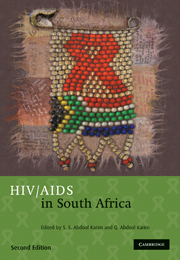Book contents
- Frontmatter
- Contents
- List of Contributors
- Foreword: Peter Piot
- Foreword: Nelson R Mandela
- Acknowledgements
- Section 1 Birth of a rapidly growing epidemic
- Section 2 The virus, the human host and their interactions
- Section 3 HIV risk factors and prevention strategiess
- 9 Reducing sexual risk behaviours: theory and research, successes and challenges
- 10 Barrier methods
- 11 Mother-to-child transmission (MTCT) of HIV-1
- 12 Sexually transmitted infections
- 13 Safe blood supplies
- 14 Intravenous drug use in South Africa
- 15 Positive prevention interventions
- 16 New prevention strategies under development and investigation
- Section 4 Focal groups for understanding the HIV epidemic
- Section 5 The impact of AIDS
- Section 6 Treating HIV
- Section 7 What does the future hold?
- Index
15 - Positive prevention interventions
Published online by Cambridge University Press: 07 September 2011
- Frontmatter
- Contents
- List of Contributors
- Foreword: Peter Piot
- Foreword: Nelson R Mandela
- Acknowledgements
- Section 1 Birth of a rapidly growing epidemic
- Section 2 The virus, the human host and their interactions
- Section 3 HIV risk factors and prevention strategiess
- 9 Reducing sexual risk behaviours: theory and research, successes and challenges
- 10 Barrier methods
- 11 Mother-to-child transmission (MTCT) of HIV-1
- 12 Sexually transmitted infections
- 13 Safe blood supplies
- 14 Intravenous drug use in South Africa
- 15 Positive prevention interventions
- 16 New prevention strategies under development and investigation
- Section 4 Focal groups for understanding the HIV epidemic
- Section 5 The impact of AIDS
- Section 6 Treating HIV
- Section 7 What does the future hold?
- Index
Summary
POSITIVE PREVENTION TARGETS PEOPLE who have tested HIV positive in order to reduce their risk of transmitting HIV to sexual and injection drug-using partners.
Differentiated from generalised prevention, which targets everyone at risk for hiv as well as those who are hiv infected but have not yet undergone hiv testing, positive prevention requires the target population to self disclose their hiv status in order to access prevention services. In this chapter, the history of positive prevention and its relevance to hiv prevention in South Africa's generalised hiv/aids epidemic is discussed, particularly with respect to continued hiv transmission risk behaviours. An overview of positive prevention interventions and how they can be adapted to the South African context is also provided. The chapter concludes with recommendations for integrating positive prevention within a comprehensive hiv prevention plan.
History of positive prevention
Throughout the first decade of the global recognition of the aids epidemics, there was little research into the hiv transmission risk behaviours of people who have tested hiv positive. In contrast to receiving an hiv negative test result, which rarely results in substantial behaviour change, most research shows that testing hiv positive is followed by dramatic reductions in unprotected sexual behaviour. Not all people who test hiv positive completely stop risky behaviour, with its potential for transmitting hiv to others. In spite of this there was little research throughout the early 1990s on those hiv positive individuals who continue to practise hiv transmission risk behaviours.
- Type
- Chapter
- Information
- HIV/AIDS in South Africa , pp. 250 - 267Publisher: Cambridge University PressPrint publication year: 2010

